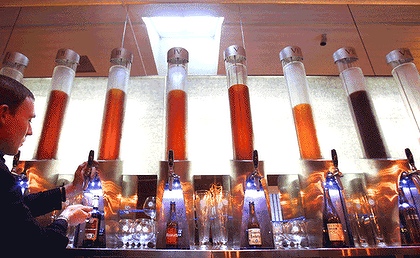I do a lot of grilling, or barbecuing as it’s known in Ontario (that’s in Canada). One of the best things about living in North Carolina is I don’t often have to be outside in snow or sleet while I roast a pork tenderloin, beer can chicken or burgers.
One of my favorite grilling partners, Matt Shipman and I talked grilling and burger food safety this week and the results were posted at The Abstract.
For many people, the sound of burgers sizzling on the grill is enough to make their mouths water. Grilling burgers is a great opportunity to spend time with family and friends, whether it’s at a summer party in the backyard or tailgating in the autumn. But grilling burgers can also lead to vomiting, diarrhea and all the other health effects associated with foodborne illness.
To help you and your loved ones avoid barfing this grilling season, we talked to NC State University food safety expert Ben Chapman. And he gave us these five things to remember when it comes to making a delicious (and safe) burger.
1) Color Stinks. Most people think you can tell whether a burger is done by the color of the meat. Those people are wrong.
“A burger can be undercooked, and unsafe, but still be brown in the middle,” Chapman says. “Or a burger can be well cooked, and safe, but still be pink or red. Color is determined by a lot of factors other temperature.”
And you really want to make sure your burger is cooked properly. Ground beef has been linked to foodborne illnesses caused by Shiga toxin-producing E. coli (STEC) and Salmonella, while ground turkey and chicken have been linked to Salmonella and Campylobacter.
2) Temperature Rules. The only way to be sure your burger is safely cooked is to observe these basic rules related to time and temperature:
For beef and bison, burgers need to be cooked until their internal temperature reaches 155 degrees Fahrenheit (and stays at that temperature for 15 seconds), or until the internal temperature reaches 160 °F;
For chicken and turkey, burgers need to be cooked to 165 degrees Fahrenheit.
And that means you’ll need a thermometer; preferably, a digital, tip-sensitive thermometer.
“Dial-based thermometers are often inaccurate and unreliable,” Chapman says. “Plus, digital thermometers make you a better cook – you’re less likely to overcook your meat if you use one.”
In addition, you’ll want to make sure to check the temperature of your burgers at multiple spots, because temperature at different spots in a single burger can vary by as much as 20 degrees Fahrenheit.
3) Grind-It-Yourself Isn’t Safer. Some people think that buying steak and grinding their own burger is safer than buying ground beef. It’s not.
“The same pathogens we find in ground beef are also found on the outside of whole muscle beef,” Chapman says. “And with ground beef risks, because Shigatoxin-producing E. coli is considered an adulterant, the industry is looking for it much more closely. There isn’t data to show that grinding your own beef is safer, and if you grind something that isn’t intended to be ground you may actually increase your risk.”
4) All Ground Meat Carries Risks. But those risks vary. For example, STEC are much more common in ground beef than in ground poultry, whereas Campylobacter are much more common in ground turkey and chicken. Either pathogen can cause both acute and long-term illnesses – but illnesses caused by STEC are more likely to be fatal.
In other words: cook your burgers to a safe temperature. Especially if you’ll be serving those burgers to children, older adults, or people with a compromised immune system (like patients undergoing chemotherapy).
5) It’s Not Just Cooking. Even if you cook a burger properly, you could still get sick if you didn’t handle the raw meat properly. That’s because of “cross-contamination,” in which pathogens from the uncooked food are transferred to food that’s ready to eat.
“In general, foodborne pathogens have a 10 percent transfer rate,” Chapman says. “So, if there are 10,000 colony-forming units, or cells, in the raw meat you touch with your hand, an average of 1,000 of them would transfer to your hand. Then, if you touched a hamburger bun without washing your hand, you could transfer 100 of those cells onto the bun and – ultimately – into your mouth.
“To avoid cross-contamination, make sure the plate that carried the raw burgers is cleaned and sanitized before any other food touches it (including the cooked burgers),” Chapman says. “You also need to clean and sanitize any utensils that touch the raw meat, such as tongs or flippers, and make sure to wash your hands any time you touch raw meat.”
Now…who wants cheese on theirs?





(1).jpg)
.jpg)
 Memorial Day, celebrated annually on the last Monday of May, also marks the unofficial start to summer, with public pools opening, barbecues fired up, and hockey playoffs (the last one may just be me, with game 2 of the National Hockey League finals tonight).
Memorial Day, celebrated annually on the last Monday of May, also marks the unofficial start to summer, with public pools opening, barbecues fired up, and hockey playoffs (the last one may just be me, with game 2 of the National Hockey League finals tonight). brews are savoured in much the same way as a fine whisky or brandy, generally sipped slowly in 30-millilitre drams. Most can be kept for a few days after being opened without spoiling and some come with reusable stoppers.
brews are savoured in much the same way as a fine whisky or brandy, generally sipped slowly in 30-millilitre drams. Most can be kept for a few days after being opened without spoiling and some come with reusable stoppers.
